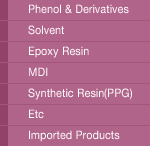| |
 BISPHENOL
MSDS BISPHENOL
MSDS |
|
| Bisphenol
- A |
| 1.
IDENTIFICATION OF THE SUBSTACE/PREPARATION
AND COMPANY |
| Chemical
Identity : Diphenyol propane
Common name : Bisphenol-A |
Registration
number
CAS No. : 80 - 05 -7 |
| Product
Type : Chemical intermediate |
Supplier
Kumho P&B Chemical Co., Ltd.
144-14, Wolha-dong, Yochon. Cholla
Namdo, Korea
Tel : (061) 685-688-3500 |
|
| 2. COMPOSITION/INFORMATION
ON INGREDIENTS |
 |
|
|
Composition
High purity diphenyol propane (Bisphenol-A)
Information on Ingredients
dangerous substances % (m/m)
% (m/m) Symbols
Symbols Rsisk Phraese
Rsisk Phraese
 Diphenyolpropane Diphenyolpropane
 >99 >99 R36
R36
|
|
| |
| |
| 5. FIRE
- FIGHTING MEASURES |
 |
|
Extinguish media
SMALL FIRE LARGE
FIRE LARGE
FIRE
·Carbone dioxide ·foam ·foam
·Dry chemical powder ·Water
spray ·Water
spray
·Foam
·Stand/Earth
·Use water as a spray
Hazards
·This product is not in the flammable
range but will burn
·Carbon monoxide is possible where
incomplete combustion occurs
Protective equipment
·Wear self-contained breathing appratus
for a large fir
|
|
| 6. ACCIDENTAL
RELEASE MEASURES |
 |
|
Leaks and spills
·Extinguish any naked flames
·all spillages should be cleared up
quickly
Small spillage
·Sweep/shovel up and remove to a
safe places for subsequent disposal
·Flush the contaminated area with
plenty of water
Large spillage
·Transfer to a salvage drum/tank
if possible, otherwise treat as for
a small spillage
Personal protection
·Refer Section 8
·In the event of inhalation risk wear
high efficiency dust respirator(NPF
1000) |
|
| 7. HANDLING
AND STORAGE |
 |
|
Handling
·Danger of dust explosion
·Maintain adequate ventilation
·Electrostatic charges may be generated
during handling, e.g. when crushing,
grinding and sewing or emptying
bags
·All equipment should be earthed,
including funnels, chutes and drums
Storage
·Satisfactory : carbonb steel, stainless
steel, aluminium, polyethylene and
paper bags
·Unsatisfactory : cooper, bronze
Storage conditions
·Store in cool, dry conditions |
| 8. EXPOSURE
CONTROLS/PERSONAL PROTECTION |
 |
|
Exposure controls
·Although no exposure limit has been
established for this product, an exposure
limit of 10 mg/m3 for nuisance
dusts and 6 mg/m3 for respirable dusts
should be observed.
Personal protection
·Respiratory : not normally required
in the event of inhalation risk use
with local exhaust ventilation
If this is not practical wear a general
purpose dust respirator(NPF 7-10)
·Hand : PVC gloves
·Eye : chemical monogoggles
·Skin : standard issue work clothes
chemical resistant safety boots without
lace holes
|
|
| 9. PHYSICAL
AND CHEMICAL PROPERITIES (typical
values) |
 |
|
Appearance (20 °C) : powder
odour : Mild
pH :
Boiling point/range : 360 °C
Melting point : 156.5 °C
Flash point(CC) : 207 °C
Flammability : Not classified as
flammable but will burn if ignited
Autoflammability : 570 °C
Explosive properties(limits) : LEL
= 12g/m3(dust cloud)
Oxidising properties : None
Vapour pressure(170 °C) : 2.6Pa
Relative density(25 °C) : 1.17
Solubility
- In water : 0.1% m/m (25 °C)
- In other solvents : Various org.
solvents
Partition coefficient
n-octanol/water : log Pow = 2.2
Relative vapour density (air=1)
Viscosity(160 °C) : 3.55mPa.s
Color : White
Relative molecular mass : 228
Specific conductivity : |
|
| 10.
STABILITY AND REACTIVITY |
 |
|
Stability
·Stable under normal conditions at ambient
temperature
·Can function as antioxidant
Conditions to avoid
·Decomposes above 11 mbar pressure
when heated above 220 °C
Materials to avoid
·Readily undergoes condensation reactions
Hazardous decomposition products |
|
| 11.
TOXICOLOGICAL INFORMATION |
 |
|
Acute toxicity
·Oral(rat) LD : > 2000mg/kg
·Dermal(rabbit) LD : > 2000mg/kg
·Inhalation(rat) LC :
Irritation
·Skin : Slight
·Eyes : Moderate
·Respiratory :
Sensitisation
·Not a skin sensitizer
Other toxicological effects
·There is no conclusive evidence
for carcinogenic or mutagenic(direct
or indirect) potential not teratogenic
following oral administration; foatotoxicity
and reproductive effects are only
observed at maternally toxic
doses |
|
| 12.
ECOLOGICAL INFORMATION |
 |
|
Ecotoxicity
·Fish LC (96h) : 3.9 mg/L
·Daphnia (water fiea) EC (48h) : 3.9
mg/L
·Algae EC (96h) : 2.5 mg/L
·Bacteria EC ( 8h) : 55 mg/L
Persistence
Degradation
·Biotic(5 days) : inherently biodegradable
·Abiotic :
Bioaccumulation : moderate potential |
|
| 13.
DISPOSAL CONSIDERATIONS |
 |
|
·Disposal : dispose to incinerator
·Classification |
|
| 14.
OTHER INFORMATION |
 |
|
Uses and restrictions
Application
·raw material in preparation of epoxy
resins and polycarbonate resin manufacture |
SDS distribution
·It is recommended that the handling
and safety information presented in
this data sheet be passed on in an appropriata
format, to your customers and handlers |
|
History
Edition Number Date of Issue
1 July 1, 1994 |
|


